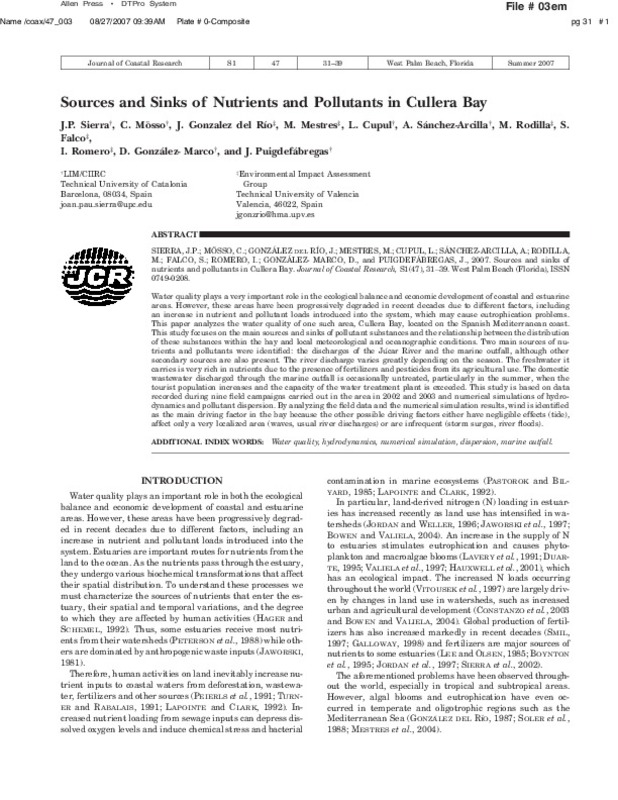JavaScript is disabled for your browser. Some features of this site may not work without it.
Buscar en RiuNet
Listar
Mi cuenta
Estadísticas
Ayuda RiuNet
Admin. UPV
Sources and sinks of nutrients and pollutants in Cullera Bay
Mostrar el registro sencillo del ítem
Ficheros en el ítem
| dc.contributor.author | Sierra, J.P.
|
es_ES |
| dc.contributor.author | Mösso, C
|
es_ES |
| dc.contributor.author | González del Rio Rams, Julio
|
es_ES |
| dc.contributor.author | Mestres, M.
|
es_ES |
| dc.contributor.author | Cupul, L.
|
es_ES |
| dc.contributor.author | Sánchez-Arcilla, A.
|
es_ES |
| dc.contributor.author | Rodilla Alamá, Miguel
|
es_ES |
| dc.contributor.author | Falco Giaccaglia, Silvia Laura
|
es_ES |
| dc.contributor.author | Romero Gil, Inmaculada
|
es_ES |
| dc.contributor.author | Gónzalez-Marco, D.
|
es_ES |
| dc.contributor.author | Puigdefábregas, J.
|
es_ES |
| dc.date.accessioned | 2014-03-05T08:35:38Z | |
| dc.date.available | 2014-03-05T08:35:38Z | |
| dc.date.issued | 2007 | |
| dc.identifier.issn | 0749-0208 | |
| dc.identifier.uri | http://hdl.handle.net/10251/36180 | |
| dc.description.abstract | [EN] Water quality plays a very important role in the ecological balance and economic development of coastal and estuarine areas. However, these areas have been progressively degraded in recent decades due to different factors, including an increase in nutrient and pollutant loads introduced into the system, which may cause eutrophication problems. This paper analyzes the water quality of one such area, Cullera Bay, located on the Spanish Mediterranean coast. This study focuses on the main sources and sinks of pollutant substances and the relationship between the distribution of these substances within the bay and local meteorological and oceanographic conditions. Two main sources of nutrients and pollutants were identified: the discharges of the Júcar River and the marine outfall, although other secondary sources are also present. The river discharge varies greatly depending on the season. The freshwater it carries is very rich in nutrients due to the presence of fertilizers and pesticides from its agricultural use. The domestic wastewater discharged through the marine outfall is occasionally untreated, particularly in the summer, when the tourist population increases and the capacity of the water treatment plant is exceeded. This study is based on data recorded during nine field campaigns carried out in the area in 2002 and 2003 and numerical simulations of hydrodynamics and pollutant dispersion. By analyzing the field data and the numerical simulation results, wind is identified as the main driving factor in the bay because the other possible driving factors either have negligible effects (tide), affect only a very localized area (waves, usual river discharges) or are infrequent (storm surges, river floods). | es_ES |
| dc.description.sponsorship | The European Community funded this study as a part of the ECOSUD ‘‘Estuaries and Coastal Areas. Basis and Tools for a More Sustainable Development’’ (reference no. ICA4-CT-2001-10027) and AQUAS ‘‘Water quality and sustainable aquaculture. Links and implications’’ (reference no. INCOCT-2005-015105) projects. It was also funded by the Spanish Ministry of Science and Technology, through the project ‘‘Desarrollo y optimizacio´n de te´cnicas para gestionar los vertidos de aguas residuales de emisarios submarinos (ARTEMISA)’’(Reference no. REN2003-07585-C02-01/MAR). | |
| dc.format.extent | 9 | es_ES |
| dc.language | Inglés | es_ES |
| dc.publisher | Coastal Education and Research Foundation (CERF) | es_ES |
| dc.relation.ispartof | Journal of Coastal Research | es_ES |
| dc.rights | Reserva de todos los derechos | es_ES |
| dc.subject | Water quality | es_ES |
| dc.subject | Hydrodynamics | es_ES |
| dc.subject | Numerical simulation | es_ES |
| dc.subject | Dispersion | es_ES |
| dc.subject | Marine outfall | es_ES |
| dc.subject.classification | TECNOLOGIA DEL MEDIO AMBIENTE | es_ES |
| dc.title | Sources and sinks of nutrients and pollutants in Cullera Bay | es_ES |
| dc.type | Artículo | es_ES |
| dc.identifier.doi | 10.2112/1551-5036-47.sp1.31 | es_ES |
| dc.relation.projectID | info:eu-repo/grantAgreement/EC/FP5/ICA4-CT-2001-10027/EU/Estuaries and coastal areas. basis and tools for a more sustainable development/ECOSUD/ | es_ES |
| dc.relation.projectID | info:eu-repo/grantAgreement/EC/FP6/15105/EU/WATER QUALITY AND SUSTAINABLE AQUACULTURE: LINKS AND IMPLICATIONS/AQUAS/ | es_ES |
| dc.relation.projectID | info:eu-repo/grantAgreement/MICYT//REN2003-07585-C02-01/ | es_ES |
| dc.rights.accessRights | Abierto | es_ES |
| dc.contributor.affiliation | Universitat Politècnica de València. Departamento de Ingeniería Hidráulica y Medio Ambiente - Departament d'Enginyeria Hidràulica i Medi Ambient | es_ES |
| dc.contributor.affiliation | Universitat Politècnica de València. Instituto de Investigación para la Gestión Integral de Zonas Costeras - Institut d'Investigació per a la Gestió Integral de Zones Costaneres | es_ES |
| dc.description.bibliographicCitation | Sierra, J.; Mösso, C.; González Del Rio Rams, J.; Mestres, M.; Cupul, L.; Sánchez-Arcilla, A.; Rodilla Alamá, M.... (2007). Sources and sinks of nutrients and pollutants in Cullera Bay. Journal of Coastal Research. SI47:31-39. https://doi.org/10.2112/1551-5036-47.sp1.31 | es_ES |
| dc.description.accrualMethod | S | es_ES |
| dc.relation.publisherversion | http://dx.doi.org/10.2112/1551-5036-47.sp1.31 | es_ES |
| dc.description.upvformatpinicio | 31 | es_ES |
| dc.description.upvformatpfin | 39 | es_ES |
| dc.type.version | info:eu-repo/semantics/publishedVersion | es_ES |
| dc.description.volume | SI47 | es_ES |
| dc.relation.senia | 31487 | |
| dc.contributor.funder | European Commission | |
| dc.contributor.funder | Ministerio de Ciencia y Tecnología |








